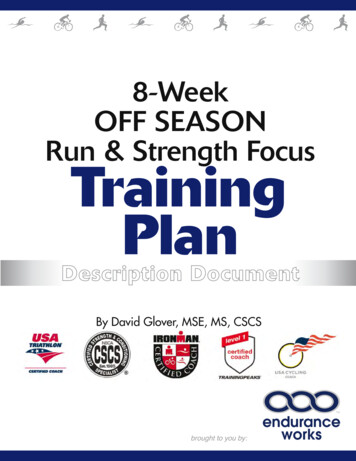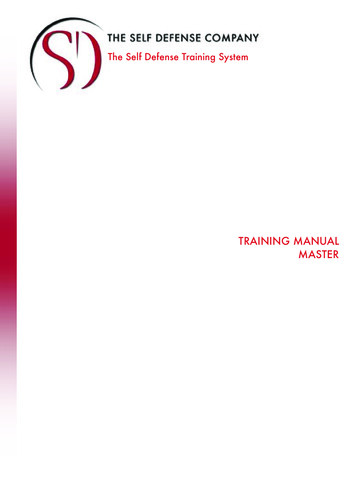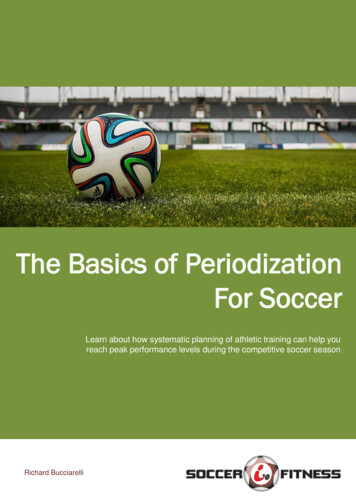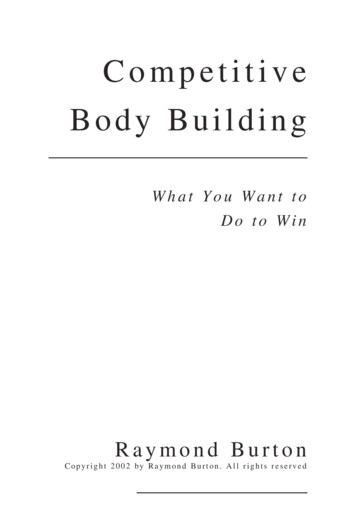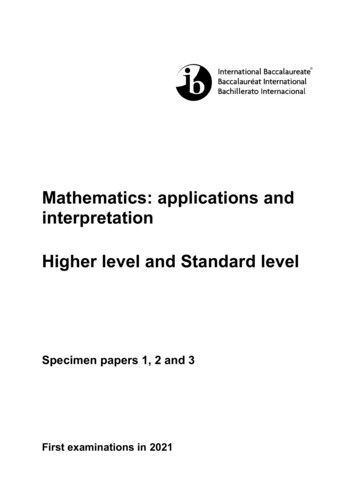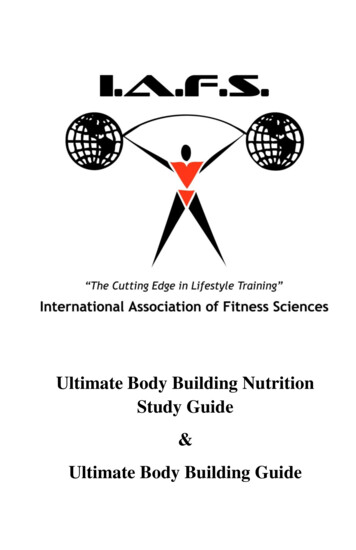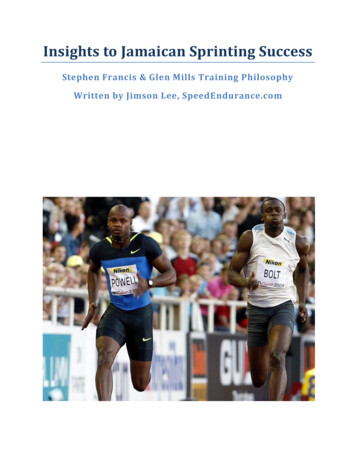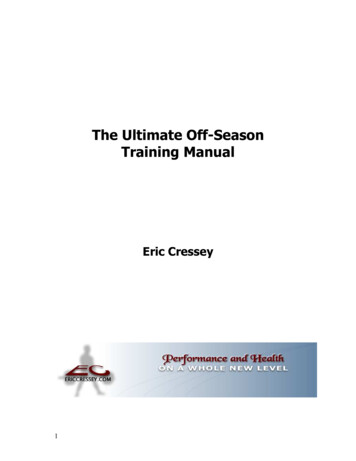
Transcription
The Ultimate Off-SeasonTraining ManualEric Cressey1
Copyright 2006 by Eric Cressey. All Rights Reserved.No portion of this manual may be used, reproduced ortransmitted in any form or by any means, electronic ormechanical, including fax, photocopy, recording or anyinformation storage and retrieval system by anyone but thepurchaser for their own personal use. This manual may not bereproduced in any form without the express written permissionof Eric Cressey, except in the case of a reviewer who wishes toquote brief passages for the sake of a review written forinclusions in a magazine, newspaper, or journal – and thesecases require written approval from Eric Cressey prior topublication.For more information, please contact:Eric Cresseyc/o Cressey Training Systems, LLC577 Main St.Suite 150Hudson, MA 01749Phone: (978) 212-2688Email: ec@ericccressey.comWebsites: www.EricCressey.comwww.CresseyPerformance.com-2The Ultimate Off-Season Training Manual Eric Cressey, 2006www.EricCressey.com
DisclaimerThe information in this book is offered for educational purposesonly; the reader should be cautioned that there is an inherentrisk assumed by the participant with any form of physicalactivity. With that in mind, those participating in strength andconditioning programs should check with their physician prior toinitiating such activities. Anyone participating in these activitiesshould understand that such training initiatives may bedangerous if performed incorrectly. The author assumes noliability for injury; this is purely an educational manual to guidethose already proficient with the demands of suchprogramming.-3The Ultimate Off-Season Training Manual Eric Cressey, 2006www.EricCressey.com
DedicationTo my grandparents, Ellen and Marty Fagan, for your unyieldinglove and unwavering support. Thank you for showing the restof us the true meaning of “family.”-4The Ultimate Off-Season Training Manual Eric Cressey, 2006www.EricCressey.com
Foreword“One’s first step in wisdom is to question everything –and one’s last is to come to terms with everything.”-Georg Christoph Lichtenburg-5The Ultimate Off-Season Training Manual Eric Cressey, 2006www.EricCressey.com
Not a week goes by that I don’t receive a dozen emailsfrom athletes who want the secret to getting bigger, leaner,faster, stronger, and more agile in the off-season. They don’twant to just improve; they want to dominate their competitionwhen the next season arrives.While I absolutely love their enthusiasm, dealing withthese individuals can actually be extremely frustrating. They allwant results, and they all want them yesterday, but apparentlythey don’t like it when I refuse to tell them what they want tohear.As you scan the pages that follow, many of you willprobably feel just as confused as those emailing me do; youmight even disagree with me to the point of refusing to readon. However, before you do, ask yourself if you disagree withme because you feel that I’m genuinely wrong in my reasoning,or because my reasoning simply calls into question principlesand practices to which you’ve adhered for years.Whether you’re a coach, parent, or an athleteyourself, this book might not be what you want to hear,but it is something that you need to hear.In reading this novel, you can expect to rethink what youare doing and possibly even regret what you have done in thepast. In the process, I hope that you’ll all walk away from thistext with a new paradigm with which to view off-seasontraining.-6The Ultimate Off-Season Training Manual Eric Cressey, 2006www.EricCressey.com
Conversely, you should not expect to find programmingthat you can simply copy and paste to use with your athletes,clients, children, or yourself. I am a firm believer that thesingle-most important component of preparing for athleticsuccess and physical transformation is individualization, andthat belief will resound throughout this book. All athletes areunique, and programming must reflect each athlete’s distinctiveneeds.Yes, I have included sample templates at the end of thismanual; however, the purpose of these templates is todemonstrate a sample “whole” created from dozens ofconstituent parts. If you want to learn how to create programsthat address your unique needs as a coach and athlete, it’simperative that you first look to the chapters that precede thesample programming. These chapters outline the means to theend; the programs alone will not tell you much – and they maynot be suitable for you.If you’re a coach looking to existing literature as a meansof “pirating” programs for your athletes, you need to considerwhether doing so is in the best interests of your athletes or justthe individual marketing the cookie-cutter program. In no wayam I intending to come across as condescending, as I’ll be thefirst to admit that all coaches – myself included – have areas inwhich they need to grow.Rather, my message is that downright terrible coachesdon’t look to the literature at all. Mediocre coaches look tothese resources so that they can have someone else tell themexactly what to do. The best coaches read diligently and-7The Ultimate Off-Season Training Manual Eric Cressey, 2006www.EricCressey.com
critically, scrutinizing everything they encounter to determine ifit is correct and, if so, how it can be incorporated into theirexisting philosophies.It is my hope that you’ll treat the information that followsin this final context. You’ve already taken a key step; youpurchased this book in hopes of making your coaching andprogramming more effective in order to help your athletes.As an accomplished exercise scientist, coach, and athletemyself, it never ceases to amaze me that the problems I willoutline are even commonly found in the off-season programs ofsome of the most prominent strength and conditioningprofessionals at the highest levels. The shortcomings of suchprogramming errors are “merely” significant at the intermediatelevel; however, at the elite level, these programming flaws maycost athletes Olympic medals, national championships,individual honors, and millions of dollars in salaries andbonuses.Those of you who are familiar with my writing will likelynotice that this work deviates somewhat from my traditionalstyle, which often includes dozens of references. My rationaleis very simple: you won’t find this information in yourundergraduate textbooks or the peer-reviewed publicationsmost commonly referenced in our industry. Instead, you’ll onlyfind this information from getting in the trenches, working withathletes, and seeing what works. That’s what I’ve done, andthat’s what dozens of fantastic coaches with whom Icorrespond on a weekly basis have done.-8The Ultimate Off-Season Training Manual Eric Cressey, 2006www.EricCressey.com
If there is information in this text, you can assume that itis the result of countless hours of planning, coaching, andinterpreting the results we’ve found. It’s all about readingbetween the lines – not just referencing what’s on the lines.This is a guide for the practitioner – whether he is a coachor an athlete. If you are someone interested in reading areview of scientific literature that simply doesn’t cut it in thereal world – where “what is” predominates over “what shouldbe” – this manual isn’t for you.As powerlifter and coach Dave Tate, one of my mentorsand friends, has said: “Science tells us what we did.” Sciencemight point you in the right direction, but it should never tellyou what to do. Instead, experimentation validated withresults should tell you what works – and just as importantly,what you use in future situations to guarantee success.Therefore, it should come as no surprise thatexperimentation in training settings around the world isoccurring every day. New anecdotal and scientific evidenceabounds, and we must seek it out. Our perspectives should beconstantly evolving as new information becomes available tous.With that in mind, interpret the information in this book asa 2006 snapshot; many of these ideas may evolve in the yearsto come. Continue to read and scrutinize, and you’ll be at thetop of your field and your game.-9The Ultimate Off-Season Training Manual Eric Cressey, 2006www.EricCressey.com
It’s time to put hidden agendas aside and apply scientificprinciples and some actual thought to our off-season trainingprograms. It’s time to get to the truth.Eric M. CresseyMay 24, 2006www.EricCressey.com-10The Ultimate Off-Season Training Manual Eric Cressey, 2006www.EricCressey.com
Table of ContentsChapter 1: IntroductionChapter 2: Counterintuition and the Black HoleChapter 3: The Problems with Modern"Speed Training Facilities"Chapter 4: Your Average Joe ExampleChapter 5: The "What:" Defining the GoalChapter 6: Learning from the Football GuysChapter 7: Is the Glass Half-Full or Half-Empty?Chapter 8: The "How"Chapter 9: The Early Off-SeasonChapter 10: Testing for Success in theEarly Off-SeasonChapter 11: The General Off-SeasonChapter 12: The Late Off-SeasonChapter 13: Pulling It All TogetherChapter 14: Sample Off-Season TemplatesReferencesAppendix A: "Cardio Confusion"About the Author-11The Ultimate Off-Season Training Manual Eric Cressey, 43150180182198
Chapter 1: Introduction“Mistakes are the portals of discovery.”-James Joyce-12The Ultimate Off-Season Training Manual Eric Cressey, 2006www.EricCressey.com
The recent surge in popularity of youth performanceenhancement training in today’s world of athletics is a fantasticthing. As I think back to my own experiences as an up-andcoming athlete, I realize that effective coaching beyond just thefield and court would definitely have made me a much betterathlete.Improving my general physical abilities would have madeit easier to learn new techniques in my sport. My balance,strength, coordination, speed, and agility would all have beenbetter. I wouldn’t have been injured as often. My confidenceboth on and off the field and court would have been better,making me an even better leader on the field and in theclassroom. I would have had more opportunities – perhapseven scholarship offers. If I had what some kids have at theirfingertips today, things could have been a lot different.In this day in age, some of us have begun to understandhow powerful the development of the general athlete really canbe – especially when that development occurs at a young age.In spite of the insistence of some overbearing individuals inpositions of authority in youth sports, we’re gradually coming torealize that early sports specialization is rarely a good thing.While we have people like Tiger Woods showing us thatearly specialization does pay off in some cases, we also have aplethora of young athletes – most notably tennis players andgymnasts – for whom early sports specialization has haddevastating consequences. The consequences of earlyspecialization may be psychological, physical, or a combinationof the two.-13The Ultimate Off-Season Training Manual Eric Cressey, 2006www.EricCressey.com
We’ve observed mental burnout leading to legal troubles,drug abuse, or simply wanting to quit. And, we’ve heard aboutoveruse injuries and conditions such as stress fractures andtendinosis. Regardless of what shortchanges these athletes inpursuit of what were once their dreams, the take-homemessage is the same: we need to let our young athletesdevelop, not specialize.As I mentioned, we’re getting to that point, thanks tocertain industry leaders and parents and coaches who really“get it.” In that sense, I’m proud of our industry; we’reprogressing toward building better athletes and better peoplewith our youth sports systems by encouraging them to playwhen the time is right and train at performance enhancementfacilities to enhance general athletic qualities.Ideally, we’ll someday see an altogether elimination ofyear-round organized competitive seasons that typify youthsports like basketball and soccer. Kids will put in their 3-5months of competition and then spend the rest of the yearparticipating in other sports to develop generally and, just asimportantly, experience some fun instead of just pressure. Allthe while, these athletes should be participating in strength andconditioning measures aimed at making them better athletes –not just basketball, soccer, football, or hockey players, etc.Millions of coaches, parents, and athletes covet thisutopia, but it is not the focus of this book. Rather, my intentionin this book is to bring to light the fact that there is a largeclass of athletes who are ready to specialize. However, manyof these athletes and those coaching them are largely missing-14The Ultimate Off-Season Training Manual Eric Cressey, 2006www.EricCressey.com
the boat; they simply don’t have a true appreciation for whenor how to specialize!Amazingly, in spite of the fact that the balance hasinappropriately been shifted to the specialization end of thespectrum for much too long, athletes and coaches still haven’tbeen learning important lessons on how to make it work whenthe time is right. My goal in this book is to teach you not onlywhen to specialize, but how to specialize when that crucial timearises.-15The Ultimate Off-Season Training Manual Eric Cressey, 2006www.EricCressey.com
Chapter 2:Counterintuition and the Black Hole“Perhaps the most valuable result of all education is the abilityto make yourself do the thing you have to do, when it oughtto be done, whether you like it or not; it is the first lessonthat ought to be learned; and however early a man’s trainingbegins, it is probably the last lesson that he learns thoroughly.”-Thomas H. Huxley-16The Ultimate Off-Season Training Manual Eric Cressey, 2006www.EricCressey.com
The Athletic ContinuumAll athletic endeavors fall on some point along an aerobicanaerobic continuum, with the vast majority falling somewherein the middle. As such, in looking to select the trainingapproaches most conducive to an athlete’s goals, we need tocover the “what” before we can get to the “how.”While every activity in which we participate requirescontributions from all the energy systems, the discussion athand will focus on the predominant energy systems involved ina given activity. The aerobic-anaerobic continuum is illustratedin Figure 2.1.Figure 2.1: The Aerobic-Anaerobic ContinuumVery Aerobic------------Mixed--------------Very Anaerobic-17The Ultimate Off-Season Training Manual Eric Cressey, 2006www.EricCressey.com
As an example, take Jon Boyle, a triathlete with whom Iwork.John competes in Ironman triathlons, which include a 2.4-mileswim, 112-mile bike, and 26.2-mile run. Clearly, Jon is aboutas far to the “aerobic” end of the continuum as they come.Conversely, let’s consider Greg Panora, an Elite powerlifterwith whom I worked to help correct a lower back problem.Greg’s best total (squat bench deadlift) to date is 2,365pounds at a body weight of 242 pounds.-18The Ultimate Off-Season Training Manual Eric Cressey, 2006www.EricCressey.com
As a powerlifter myself, I’ll venture a guess that Gregwouldn’t even dream of doing loads of exercise to enhance hisaerobic capacity; it’d make him weak so quickly that hewouldn’t know what hit him. We fall as far to the right(anaerobic end) of the continuum as possible, as it makes ussuccessful in our sport.With athletes like Jon and Greg in mind, let’s get a bitmore specific with our continuum with some broad examples:Triathlons-----Black Hole of Athleticism-----PowerliftersMarathons-----Black Hole of Athleticism-----ShotputYou might be wondering what this “Black Hole ofAthleticism” is. To be blunt, it’s where many coaches andathletes falter in the planning and execution of training.Virtually all team sports – including soccer, field hockey,lacrosse, hockey, football, and volleyball (in that order, left toright) – fall into this black hole.Each sport will have its own unique place along thecontinuum within this black hole, so the challenge in programdesign is to determine where the “ideal” position along thiscontinuum is for a particular sport. And, more specifically, onemust understand where each athlete in that sport fits based onindividual and positional factors. Only then can a coacheffectively program for the entire training year and – specific tothe present discussion – the off-season.-19The Ultimate Off-Season Training Manual Eric Cressey, 2006www.EricCressey.com
Training in the Black HoleIntuitively, it would seem that the best way to fall intoone’s appropriate place on this continuum in order to maximizeperformance would be to simply participate in one’s sport yearround. This participation would, of course, be supplementedwith conditioning sessions that are specific to the metabolicdemands of the sport in question.This widespread, yet completely incorrect assumptionis clearly evidenced by the surge in popularity of young-athletetraining centers pushing year-round cookie-cutter group“speed” training sessions. While marketed as “speed” sessions,these interventions are in fact poorly supervised, non-scientific,random running drills that only condition the athletes to moveat the same speed for longer – but never at a faster speed.There is a noteworthy difference between “conditioning”sessions and “speed” training. The former serves only toenhance short-term metabolic preparedness, while the latterseeks to effect favorable changes in the powerfulneuromuscular system that governs performance via long-termadaptations.Again, my intention is not to criticize; I’m glad that ourindustry is growing in popularity and we’re attractingenthusiastic coaches. We just need to point this enthusiasm inthe right direction.-20The Ultimate Off-Season Training Manual Eric Cressey, 2006www.EricCressey.com
Chapter 3: The Problems withModern “Speed Training” Facilities“Honesty pays, but it doesn’t seemto pay enough to suit some people.”-F.M. Hubbard-21The Ultimate Off-Season Training Manual Eric Cressey, 2006www.EricCressey.com
The Status QuoEven the most novice student of exercise physiology couldnot ignore the fundamental shortcomings of the “speed”programs in today’s cookie-cutter facilities. Nonetheless, theindividuals writing such programs continue to steadfastlyadhere to such modalities. Why? As my fifth-grade teachertaught me, “Money makes the world go round.” Specifically:1. Conditioning sessions allow a coach to “supervise” (and Iuse that term very loosely, in the case of these facilities)several athletes at once, so it is possible to improve thefacility’s bottom line through sheer volume of participantsand a high participant-to-coach ratio.2. Conditioning sessions require less educated and skilledcoaches who can obviously be paid lower wages. In manycases, these facilities simply have their uneducated internssupervise such sessions. It takes much less knowledge tosimply tell an athlete to run than it does to instruct anathlete how to run; identify technique flaws, structuralimbalances, and biomechanical inefficiencies; and implementprograms that will improve neuromuscular efficiency and, inturn, performance.-22The Ultimate Off-Season Training Manual Eric Cressey, 2006www.EricCressey.com
It’s much easier to tell a young athlete to“just run” than it is to teach him how torun faster and implement programming thatwill make him stronger and more powerful.3. Conditioning sessions do not typically last as long assessions geared toward improving neuromuscular efficiency.When training for speed, strength, and optimal technique,athletes must be allowed sufficient rest periods betweenefforts; therefore, effective sessions require considerabletime devoted to short-term recuperation.Conditioning sessions, on the other hand, are based on theconcept of increasing training density – doing more work inthe given period of time – to improve sport-specificendurance. The more athletes a facility can “run throughthe gauntlet” in a day, the easier it is for the owners to paythe rent and buy fancy sports cars.4. Conditioning sessions require very little equipment; somecones, a whistle, and maybe a stopwatch will get the jobdone. Training to improve neuromuscular function almostalways requires the use of outside implements – most-23The Ultimate Off-Season Training Manual Eric Cressey, 2006www.EricCressey.com
notably resistance training equipment – that are moreexpensive and require more space in a facility.5. Conducting conditioning sessions instead of programmingto improve neuromuscular function allows even the smartestsport scientists to be lazy – both in their thinking andcoaching practices.6. Metabolic conditioning is more rapidly attained thanneuromuscular efficiency. So, if a coach is more interestedin impressing a parent or athlete in a very short amount oftime in order to encourage future cash expenditures forcoaching, he’ll be able to demonstrate changes in the shortterm just by practicing a given skill (e.g., 40-yard dash).This improvement is short-lived, and such practice amountsto beating one’s head against a wall once the first plateau isencountered shortly thereafter. Neuromuscular adaptationsmay take time, but they provide a foundation for continualimprovements for the duration of an athlete’s career.Conversely, metabolic conditioning is an acute quality that ismore rapidly improved (and detrained, for that matter).-24The Ultimate Off-Season Training Manual Eric Cressey, 2006www.EricCressey.com
A Useful AnalogyTo illustrate my point, one can think of the conditioningversus neuromuscular training conundrum as a leak in the roof.Conditioning sessions are a bucket catching the water – a quickfix, if you will. Neuromuscular training addresses theunderlying problems, patching up the hole in the roof andproviding for the future.For the off-season athlete, the “holes in the roof” may berelated to any of several shortcomings: Poor maximal strength (and, more specifically, relativestrength) Poor strength-speed Poor speed-strength Poor explosive strength (rate of force development) Lack of reactive ability Insufficient mobility/dynamic flexibility Structural imbalances Technical flaws (technique should not be addressed underconditions of fatigue) Excessive body fat Soft tissue restrictions Existing injuries that require rest and/or rehabilitation(these would likely be exacerbated by the high-volumeconditioning sessions, which would just reinforce poortechnique and faulty neuromuscular compensationpatterns)-25The Ultimate Off-Season Training Manual Eric Cressey, 2006www.EricCressey.com
Where This Leaves UsThe problems seen with these facilities are oftenmagnified by the misinformation circulated by the coaches ofthe athletes’ teams. I can’t tell you how frustrating it is to dealwith a head coach who insists on long-distance running in theoff-season for athletes involved in lacrosse, soccer, fieldhockey, and – perhaps worst of all – football. Whileperformance enhancement coaches seek to do the job they’reeducated to do, some sport coaches may undermine theirefforts by pushing conditioning work that impairs an athlete’sability to address the problems noted above.This conflict of interests and recommendationsunderscores the importance of open lines of communicationbetween strength and conditioning coaches and sport coaches.A simple conversation between these two entities can oftenmake the difference between average results and phenomenalresults for the athletes with whom they work.Unfortunately, because most sport coaches, athletes,parents, and even some trainers are nothing more than casualobservers when it comes to exercise physiology, the “be ingame condition year-round” intuition often becomes the normin sport training. If you want to dominate your competition,though, you have to learn to be counterintuitive with yourtraining, especially if you participate in one of the “Black Hole”sports that requires a balance of aerobic and anaerobicqualities.-26The Ultimate Off-Season Training Manual Eric Cressey, 2006www.EricCressey.com
Simply playing one’s specific sport year-round does notallow for the optimal development of several general qualitieskey to athletic performance. With that in mind, the chaptersthat follow will outline an effective approach to off-seasonprioritization and sequencing in order to develop the generalathlete. This general foundation will, in turn, provide for theemergence of a more proficient specialized athlete down theroad.-27The Ultimate Off-Season Training Manual Eric Cressey, 2006www.EricCressey.com
Chapter 4: Your Average Joe Example“It is not worth an intelligent man’s time to be in the majority.By definition, there are already enough people to do that.”-G.H. Hardy-28The Ultimate Off-Season Training Manual Eric Cressey, 2006www.EricCressey.com
Our Average JoeI have extensive experience with basketball players at alllevels, and as a result, I have a frame of reference when I saywithout wavering that this is the sport in which these offseason problems rear their ugly heads the most. As such, ourAverage Joe will be a 20 year-old small forward playing collegebasketball.Joe grew up playing streetball, improving as much due tophysical maturity as he did due to hard work and actual gameexperience. Intuitively, Joe assumes that what has worked inthe past is sure to work forever. Unfortunately for Joe, hisassumption couldn’t be further from the truth.Our Average Joe’s “official” college basketball season runsfrom November 1 to roughly March 15 – about 18 weeks in all.Preseason games typically begin the first week in November,and the ones that count start the last week in November. Assuch, the month of October is the college basketball preseasonperiod in most coaches’ eyes.That gives Joe 30 off-season weeks per year to preparehimself to be the best player he can be. Why not 52 weeks?Those of us who have ever played a sport know that in-seasontraining will never be an ideal scenario to make progress infitness qualities (although I have still seen athletes makeremarkable progress at this time). The rigors of competition,constant pounding on the body, and the considerable aerobic-29The Ultimate Off-Season Training Manual Eric Cressey, 2006www.EricCressey.com
stimulus many athletes face make strength and speed gainsmuch tougher to attain.Why not 34 weeks? Preseason is going to be pretty darnhard on Joe; he can rule out October as a time to really makebig gains. Preseason is just like the in-season period – onlyharder! We all know that coaches like to get their athletesmentally tough with insane amounts of training volume duringthis time period.Following the “intuitive” approach, Joe spends his offseasons playing streetball, participating in voluntary on-courtworkouts with teammates, attending a summer camp or two,and playing a few hours of video games each day. It’sbasketball, basketball, and more basketball – playing(conditioning, if you will), but no real training.Nonetheless, Joe decides that he’s going to suddenlybecome extremely devoted to becoming a ridiculous athlete.Our man is actually going to hit the weight room in the offseason in addition to his hours on the court each day. And,since he’s so dead-set on becoming the next NBA superstar, hedecides that he’ll need the most intricate, individualizedprogram that will match his sudden, tremendous dedication andpersistent attitude. So, in between video games, Joe turns onhis computer and fires me an email to ask me what I think heshould do.My response (with elaboration, of course) is essentially,“Cut your time on the court by 90%. You can’t ride two horseswith one saddle, and nobody wins championships, MVP awards,-30The Ultimate Off-Season Training Manual Eric Cressey, 2006www.EricCressey.com
or even starting jobs by being in game-ready condition in theoff-season. Sometimes, the best way to improve in your sportis to avoid that sport.”Less than 1% of all the Average Joes out there will believeme the first time. The remaining 99% will either respond withsomething along the lines of “huh?” or I’ll never hear fromthem again. As I noted in the introduction, these are theindividuals who are upset that they haven’t been told what theywant to hear. They want me to tell them that playing streetballis what they need because it’s fun.-31The Ultimate Off-Season Training Manual Eric Cressey, 2006www.EricCressey.com
Why Average Just Won’t Cut ItUnfortunately for guys like Joe, there are two problemswith asking me to justify their off-season “fun.”First, I’m not a good liar, so I wouldn’t be able to sleep atnight if I just told them what they wanted to hear, only to sendthem off on a non-productive off-season journey.Second, playing isn’t training. And, to them, it followsthat training can’t be fun; the basketball world as a whole hasyet to embrace resistance training like other sports.Apparently, squats, lunges, deadlifts, presses, rows, chin-ups,and depth jumps just aren’t as satisfying as jump shots,crossovers, pick ‘n rolls, and alley-oops. I hate to publicize astereotype, but I’ve been around enough players at all levels toassure you that this is, for the most part, what is going on.Not quite as appealing as an alley-oop, is it?-32The Ultimate Off-Season Training Manual Eric Cressey, 2006www.EricCressey.com
Those with the “it’s not fun” and “lifting isn’t important forme” mindsets are destined to keep spinning their wheels.Meanwhile, the one-percenters return the following season totake their starting jobs and, worse yet, “posterize” thenaysayers in pick-up games, 30,000-seat arenas filled tocapacity, and on national television in front of millions oflaughing sports fans.So, the logical next question is, “Where are the 99%athletes failing?” Let’s depict this using a chart and ourbasketball example. In addition to using the continuum as ourx-axis, we need to account for “total fitness,” as one canimprove or detrain various qualities through
on. However, before you do, ask yourself if you disagree with me because you feel that I’m genuinely wrong in my reasoning, or because my reasoning simply calls into question principles and practices to which you’ve adhered for years. Whether you’re a coach, parent, or an athlete yoursel

